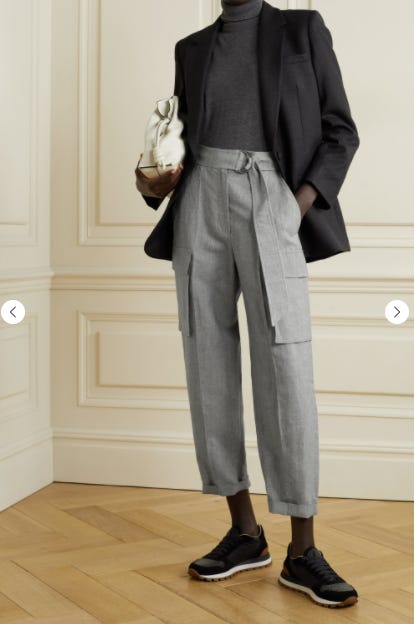#13: reverse fabric searching
As a former online fabric-store owner & frequent online fabric consumer, I completely empathize that nailing down the exact colour, drape & vibe you’re looking for via a 200 x 200 listing jpeg can often yield some … interesting results. While free swatches are often plentiful, the embattered postal system & the unending ebbs and flows of a global pandemic mean we’re often asked to make a best guess & head right to checkout. I used the following trick often when sourcing fabric for the shop, especially if trying to pinpoint a perfect partner for a buzzy pattern or hit on a seasonal sweet spot, but I hope you’ll find it a worthy tip for sourcing on your own, too!
Step 1: Pull up an inspiration image
Start with an image of a garment you’ve been inspired by – here, we’re using this very cool take on a cargo pant. This trick works best if you know the original designer and can access the item listing, but I’ve also had good luck using Google Lens or Google Reverse Image Search to hunt down the original information, or even something comparable. Once you’ve found the original (look for style name and original designer), see if you can find the item listing. Looking at an older or vintage piece? If you can find it on a resale sight, sellers will often post photos/transcripts of the label & fabric content!
It can also be helpful to jot down what got you goin’ about the original garment – was it the fluid drape? The structure? The organic texture of the weave? These notes can help guide your search, and show you how far you may want to deviate, and in which direction, from your source.
My notes on these: love how the drape & texture of this fabric elevates this casual cargo cut – this is what I’ll want to look for when hunting down similar fabric!
Step 2: Expand the ‘details’ or ‘fabric content’ section on the product page
In this case, these trousers are made out of a blended fabric that’s 54% wool, 46% linen and a lining that’s: 36% polyester, 32% acetate, 32% cupro. Sweet! Should be pretty easy to find, and can extrapolate a few further details from this info: the presence of a lining suggests that this fabric may be itchy, so will want to plot out drafting a lining in my sewing plans. As I want to replicate the basic drape & texture of this item, I can be pretty flexible on exact fabric percentages, but it’s helpful to note that these are essentially 50% ‘fine’ wool, which provides the drape & elevates the item, and 50% linen, which provides the texture and works with the casual cut. I’ll be looking for a natural fabric, with some evenly-weighted mix of wool + a lighter natural fibre like cotton, wool or silk. I’ll also want to make a best guess about the weight of the fabric in the original (this is an excellent article & infographic to help with that), as this will help narrow down my search later on.
Step 3: Start your search
Armed with your fabric content knowledge, start broad and head to Google. I find it’s best to format your search like: “fabric content + by the yard”. Often this will still be too broad, and it can be helpful to narrow your search to your favourite fabric store’s search bar or Etsy. At Mood (and many other fabric stores!) you can check boxes to narrow down to exact fibre content once you’ve made your initial search.
After scouring Google, I ended up at Mood and found a ‘close enough’ blend – a suiting that’s about 75% wool and 23% linen + silk. The suiting should mimic the drape of the original, and the fabric composition, with the similar blend of natural fibres, should hit that textured + elevated vibe I loved in the original pair of trousers.(With ample deadstock available online now, the chance that you may actually hunt down the original sample fabric is not totally unlikely, which is why I love to hit up deadstock sources first!) .
Hope this helps you navigate the murky waters of fabric composition & online fabric shopping somewhat! If nothing else, it can be a great way to build your knowledge of how different textiles & fibre blends hang, wear & sew up. Or, instead of beginning online, it can be just as fun to deep dive into your own closet, jotting down the properties of your favourite pieces & getting intimate with your preferences.
Happiest hunting,
M
Thank you so much for sticking around for a whole 12 months! I know inbox space is at a high premium, so I don't take your eyeballs and your attention lightly. This newsletter is and will remain free, but if you'd like to show your support you can buy me a coffee, hit ‘membership’ for a standing coffee date or share on social (with infinite & celestial thanks from me!).






